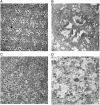Ceramidase expression facilitates membrane turnover and endocytosis of rhodopsin in photoreceptors
- PMID: 14769922
- PMCID: PMC357028
- DOI: 10.1073/pnas.0308693100
Ceramidase expression facilitates membrane turnover and endocytosis of rhodopsin in photoreceptors
Abstract
Transgenic expression of ceramidase suppresses retinal degeneration in Drosophila arrestin and phospholipase C mutants. Here, we show that expression of ceramidase facilitates the dissolution of incompletely formed and inappropriately located elements of rhabdomeric membranes in ninaE(I17) mutants lacking the G protein receptor Rh1 in R1-R6 photoreceptor cells. Ceramidase expression facilitates the endocytic turnover of Rh1. Although ceramidase expression aids the removal of internalized rhodopsin, it does not affect the turnover of Rh1 in photoreceptors maintained in dark, where Rh1 is not activated and thus has a slower turnover and a long half-life. Therefore, the phenotypic consequence of ceramidase expression in photoreceptors is caused by facilitation of endocytosis. This study provides mechanistic insight into the sphingolipid biosynthetic pathway-mediated modulation of endocytosis and suppression of retinal degeneration.
Figures




References
-
- Merrill, A. H., Jr., Schmelz, E. M., Dillehay, D. L., Spiegel, S., Shayman, J. A., Schroeder, J. J., Riley, R. T., Voss, K. A. & Wang, E. (1997) Toxicol. Appl. Pharmacol. 142, 208–225. - PubMed
-
- Hannun, Y. A., Luberto, C. & Argraves, K. M. (2001) Biochemistry 40, 4893–4903. - PubMed
-
- Acharya, U., Patel, S., Koundakjian, E., Nagashima, K., Han, X. & Acharya, J. K. (2003) Science 299, 1740–1743. - PubMed
-
- Zuker, C. S., Cowman, A. F. & Rubin, G. M. (1985) Cell 40, 851–858. - PubMed
MeSH terms
Substances
LinkOut - more resources
Full Text Sources
Molecular Biology Databases

